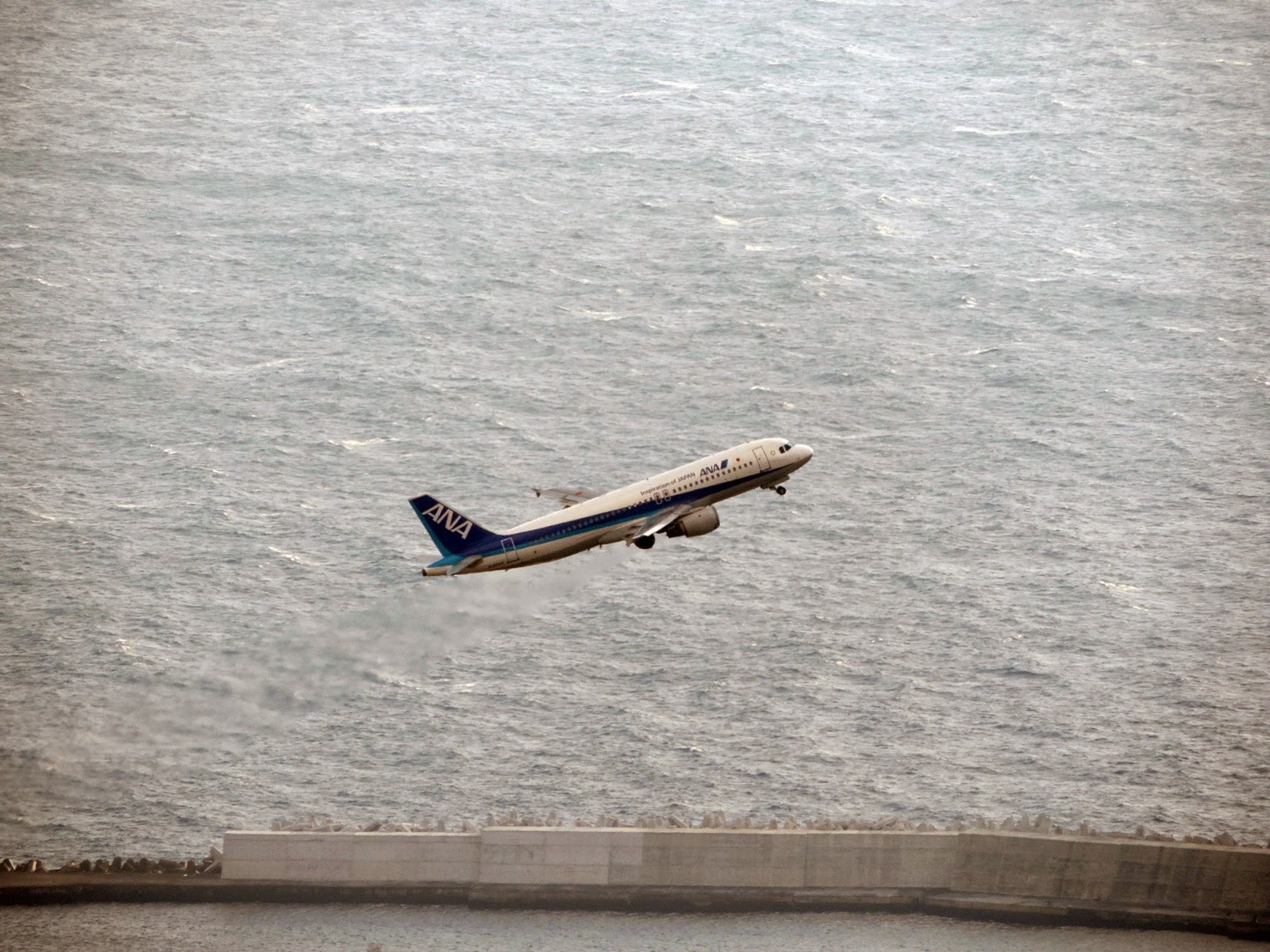The males are blue and red and the females are grey-coloured all over.
I had no luck with taking a picture of even one male.
On the (ugly) tetrapod breakwater, some cormorants were resting.
The smaller one on the right is a Pelagic Cormorant (Himeuヒメウ) and the other two are Temminck's Cormorants (Umiuウミウ).
a Temmminck's
Pelagic Cormorants
One Pelagic Cormorant was at the far end of the port and he looked very brown in the sun. I wish it wasn't so blurred!
A flying cormorant just before the sunset. We don't know which cormorant it was.
The island's shore is all dark-coloured and covered with volcanic rock.
A waterfall near Nakanogo Port is called Urami-ga-Taki.
Urami in Japanese sounds like a grudge (恨み) but actually it's written in this way '裏見ヶ滝,' meaning you can see the back of the water falling:)
See?
We were expecting to see a Wren but no luck.
There is an eco-tourism company on the island and we asked them for a guided walk for one morning. We were taken to various places on the island by an experienced guide, Iwasaki-san, and managed to see a Wren (only by K for half a second) and an Owston's Varied Tit (only by A for half a second!), both of which are sub-species of the ones on the mainland of Japan.
Also, Iwasaki-san advised us to stay at the bottom of the valley if we wanted to see Japanese Wood Pigeons (Karasubatoカラスバト). We did for nearly 2 hours on the last day of our stay and we finally saw one pigeon fly over! Well, it was like a flash but without her advice, we wouldn't have had the joy:)
Project WAVE (eco-tour organiser)
http://www3.ocn.ne.jp/~p-wave/english.html
Iwasaki-san: she was chosen as one of the best 100 eco-tourism guides in Japan!
http://old.ecotourism.gr.jp/guide100/13_010.html
We had a great time on the island even though it was a bit hard to spot birds as broad-leaved evergreen covers most of Hachijo-jima and the birds don't sing at this time of year.
The birds we saw/heard: Teals (Kogamoコガモ), Little Grebe (Kaitsuburiカイツブリ), Oriental Turtle Doves (Kijibatoキジバト), Japanese Wood Pigeons (Karasubatoカラスバト), Pelagic Cormorants (Himeuヒメウ), Temminck's Cormorants (Umiuウミウ), Ospreys (Misagoミサゴ), Goshawks (Ootakaオオタカ), Buzzards (Nosuriノスリ), Kestrels (Chobemboチョウゲンボウ), Bull-headed Shrikes (Mozuモズ), Thick-billed Crows (Hashibutogarasuハシブトガラス), Eastern Great Tits (Shijukaraシジュウカラ), Owston's Varied Tits (Osuton-yamagaraオーストンヤマガラ), Brown-eared Bulbuls (Hiyodoriヒヨドリ), Japanese Bush Warblers (Uguisuウグイス), Japanese White-eyes (Shichitoh-mejiroシチトウメジロ), Wren (Mosuke-misosazaiモスケミソサザイ), Izu Thrushes (Akakokkoアカコッコ), Dusky Thrushes (Tsugumiツグミ), Scaly Thrush (Toratsugumiトラツグミ), Daurian Redstarts (Jobitakiジョウビタキ), Blue Rock Thrushes (Isohiyodoriイソヒヨドリ), Tree Sparrows (Suzumeスズメ), Grey Wagtails (Kisekireiキセキレイ), White Wagtails (Hakusekireiハクセキレイ), Olive-backed Pipits (Binzuiビンズイ), Water Pipits (Tahibariタヒバリ), Oriental Greenfinches (Kawarahiwaカワラヒワ), Black-faced Buntings (Aojiアオジ). & Pale Thrush or Brown-headed Thrush
a view of Boso from the aeroplane















No comments:
Post a Comment